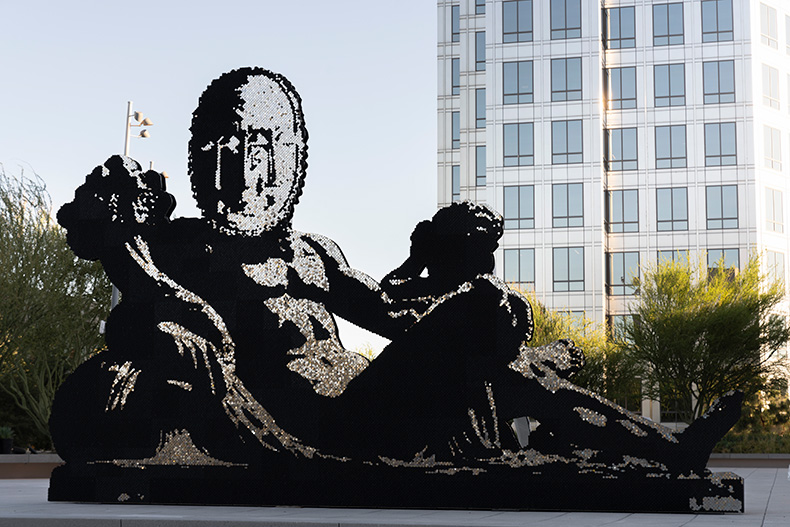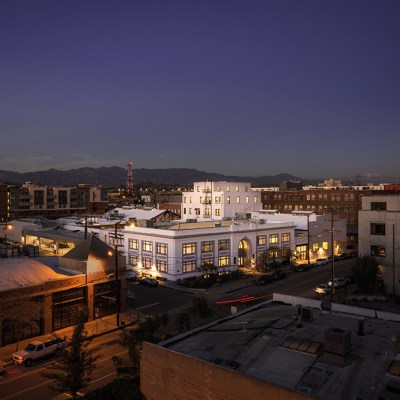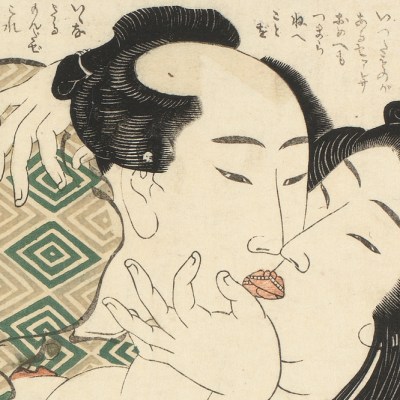‘Art matters, because the rest of the world doesn’t make sense’. This statement from the artist Sandford Biggers at the launch of the new Orange County Museum of Art (OCMA) feels all the more meaningful after several hours stuck in traffic, entertained only by custom number plates – ‘TEK M❤︎M’, ‘JUUUJ’, ‘HAHAHA’ etc. Progressing slowly through the retail estate which provides a commercial buffer for the new museum, I wonder whether it is ever worth leaving Los Angeles for the sake of art.
Luckily, however, meaning is on my side. After following various groups of school children through the plazas and performance venues that constitute the meticulously masterplanned campus of the Segerstrom Center for the Arts, I find myself at the foot of Richard Serra’s Connector (2006), the 66-foot-tall sculpture that serves as a tawny steel signpost to OCMA. A curved flight of steps – modelled on the famously public-friendly entrance of The Met in New York – leads to a raised plaza, where a huge reclining figure glitters in the sun. The sequin-studded installation, gently undermining Eurocentric archetypes of the idealised male figure, is part of Biggers’ Chimera, Shimmer, and Codex series. Yes, I think. Art does matter.
Installation view of ‘Sanford Biggers: Of many waters…’ at Orange County Museum of Art, Costa Mesa, CA. Photo: ofstudio

If Los Angeles is a haven for the weird and the abject, then Orange County is its cookie-cutter cousin. Or so I thought, before visiting the museum. While the region does have its fair share of gated communities, doggy-day-cares, Ryans and Marissas, the demographics are far more diverse than popular media would suggest. The Segerstrom Center for the Arts is an admirable endeavour to provide world-class cultural facilities in an area comparatively void of public amenities (the beach and the big-box stores aside). The structure for the new OCMA, designed by Morphosis under the direction of Pritzker Prize-winning architect Thom Mayne, strikes a balance between glitz and generosity. The building is a Covid-baby, conceived at a time when it seemed possible that people might never return to sites of gathering, and the aesthetics of the building are optimised for openness and access in a way that was rarely accommodated before the pandemic.
The undulating facade of terracotta tiles wraps from exterior to interior, leading visitors inside the galleries like molluscs in search of a shell. Once within, the spaces are surprisingly compact. The original OCMA was founded 60 years ago, and the collection comprises primarily California-centric 20th-century and contemporary art, highlighting movements such as mid-century modernism, Bay Area Figuration, California Light and Space, Pop Art, minimalism, and installation art. In 1984, the museum launched the California Biennial, and works from this year’s event are displayed in the ground-floor galleries.
Suppressing a theory that often arises when viewing the contemporary art of the region (a theory that Californian artists really like getting really high), I wander into the exhibition ‘13 Women’, inspired by the curatorial values of the women who founded the Balboa Pavilion Gallery, the earliest iteration of OCMA. Curated by the museum’s current director, Heidi Zuckerman, the exhibition feels like a touchstone of artistic integrity; presented in multiple rotations over the course of a year, the first display includes works by Alice Aycock, Joan Brown, Lee Bul, Lucy Ball, Sarah Cain, Vija Celmins, Mary Corse, Mary Heilmann, Barbara Kruger, Cady Noland, Catherine Opie, Hilary Pecis and Agnes Pelton. Momentarily confused to see Richard Diebenkorn, Ed Ruscha and John Altoon thrown into the mix, I realised that the exhibition is not making a gender-specific argument. Instead, the visitor is invited to become part of an argument about power, equality and the degree of nuance and criticality required to make good art.
Installation view of ‘Fred Eversley: Reflecting Back (the World)’ at Orange County Museum of Art, Costa Mesa, CA. Photo: ofstudio

Installed within the long, curved gallery of the museum’s mezzanine, is an exhibition dedicated to the artist-scientist-engineer Fred Eversley, surveying 30 years of his practice. Eversley’s work is beyond Light and Space; it is a movement in itself, an empirical investigation into material properties and sensate depth, transforming identities into images reflected in resin. Biggers cites Eversley as an important inspiration for his own phenomenological, kinetic and empathic explorations – and the sequined installation on the raised plaza is an ecstatic counterpart to Eversley’s sedate and weighty sculptures.
It now strikes me that Biggers’ statement of why art matters was a response to a question posed by a curator – indicating the extent to which art must prove its worth, even at the launch of a multi-million-dollar museum. While the philanthropists and museum leadership may agonise over the value and purpose of their work, it seems that the artists are content to make their own meaning. For this freeway-frazzled visitor, that is enough.
The Orange County Museum of Art opens on 8 October.


